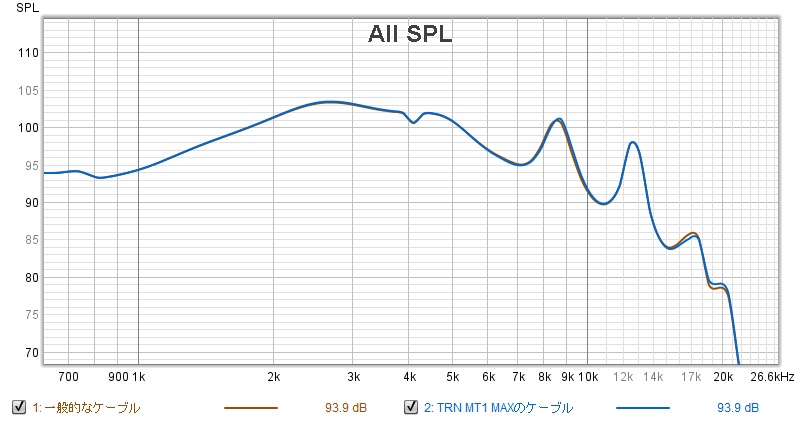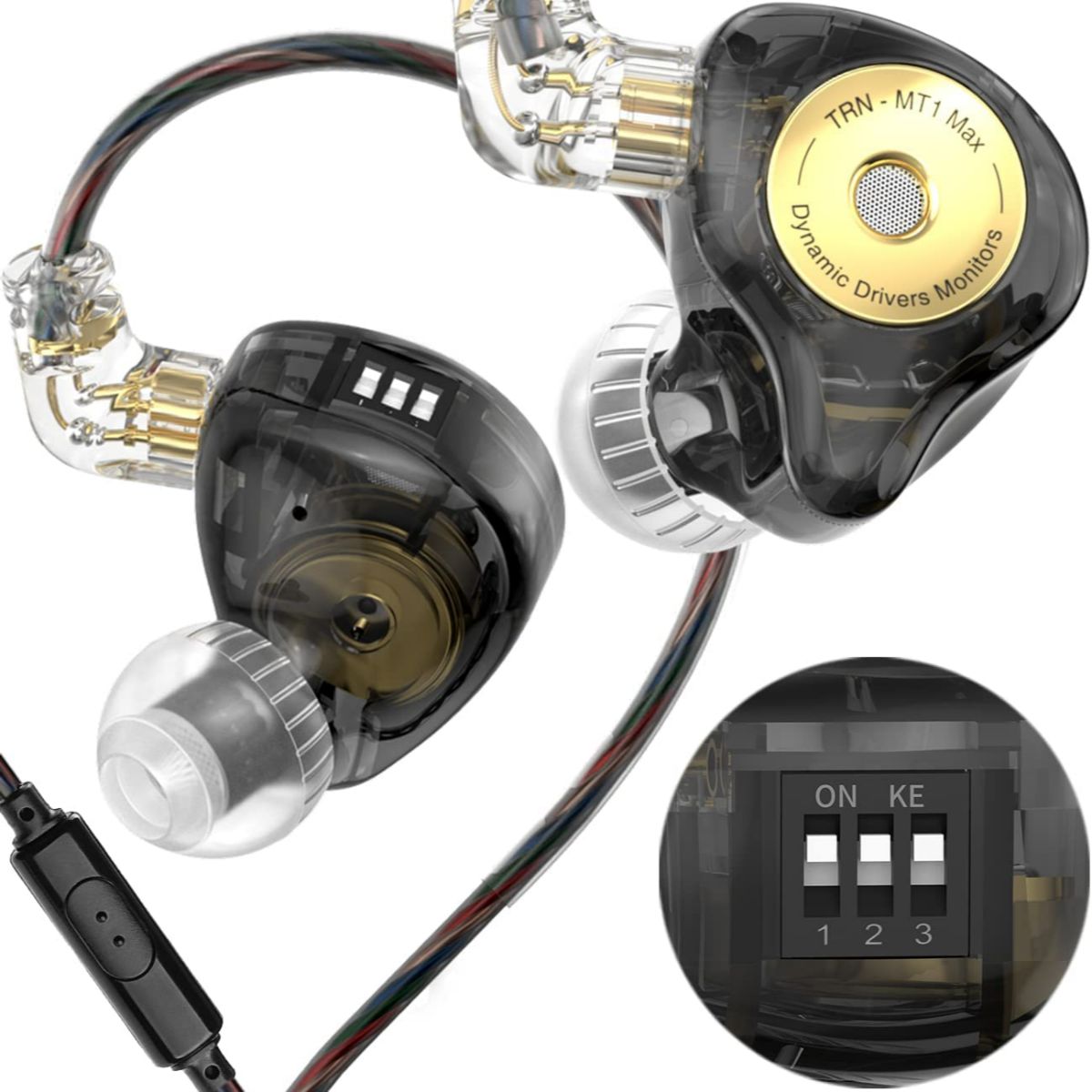The results of the survey on the difference in sound due to re-cabling of the TRN MT1 MAX are now available.
以下のページの問1の1の音源を聴いてください。https://t.co/XeCr3Lwmjv
— audio-sound @ hatena (@audio_sound_Twr) April 25, 2023
A,B,C,Dの音源のうち、1の音源に最も近いと思う音源はどれですか?
The survey collected 45 votes and the final results:
- A: 26.7%
- B: 20%
- C: 33.3%
- D: 20%
The sources of each are as follows:
- A: Hidizs MS5 high quality cable
- B: Hidizs MS5 high quality cable + 4.6 ohms
- C: TRN MT1 MAX cable + 1.6 ohms
- D: High quality cable of Hidizs MS5 + 1.6 ohms
From the measurements presented in the previous article, here are the approximate resistance values for each condition:
- A: 0.3Ω (high quality)
- B: 5.2Ω (very lower quality than TRN MT1 MAX cable)
- C: 3.8Ω (lower quality than TRN MT1 MAX cable)
- D: 2.2Ω (same quality as TRN MT1 MAX cable)

What this blind test means.
This test was to elucidate acoustically what was actually happening during the physical phase of the re-cabling (the remainder after removing the changes in the psychological situation).
The following procedure is used to record the sound source for this issue.
- Recorded with the TRN MT1 MAX attached to HATS with the TRN MT1 MAX cable on (Sound sources for the questions)
- Recorded with the same condition as in 1., adding a resistance value of 1.6Ω setting with Amari (C)
- Remove TRN MT1 MAX from HATS once and reattach it to Hidizs MS5 high quality cable as in the actual re-cabling
- Adjust the fit to be almost exactly the same while watching the measurements
- Record with Hidizs MS5 cable with different resistance values as with the TRN MT1 MAX cable (A, B, D)
In actual re-cabling, as shown in 3, there will be a difference in the fit when putting on and taking off the earphones. This difference can in some cases significantly alter the sound of the earphones. Since the fit before and after putting on and taking off the earphones is usually different, there will be a noticeable difference in sound quality and peak shift of a few dB in the low and high frequencies. In other words, the entire frequency response is changed.
In this recording, the sound quality difference between before and after the cable replacement was minimized to the level of measurement error, since the fit was very carefully adjusted based on the measured values. Even so, there is still a slight difference between the left and right sides, so the overall difference in impression is quite large, and could be larger than the difference in sound quality when the cables are replaced.
For example, I showed in a previous article using TANGZU Wan'er SG that slight differences in fit (peak shift) produce slight differences in a fairly wide range of measurement graphs.

Even a faint difference in fit, almost at the level of measurement error, could result in a slightly more complex change, such as a faint rise in some parts and a faint fall in others, unlike re-cabling, so the variation in auditory perception could be larger than the equivalent re-cabling change.
In actual situations, the wearing feeling changes slightly simply by putting on and taking off the earphones or inserting and removing the cable with force even without putting on and taking off the earphones, so the effect is likely to be larger than the measurements shown above.
The differences in fit can be summarized as follows:
- A (different fit)
- B (different fit)
- C (same fit)
- D (different fit)
Because this blind test aimed to reproduce the entire real-life re-cable experience, there is no sound source that is exactly the same as the exact questioned sound source.
The closest to the correct answer in terms of measurements is D.
However, it is possible that slight differences in fit may affect the ambience of the sound, and C may be closer to the Sound source of the question.
The results of the survey are shown previously:
- A: 26.7%
- B: 20% (most different)
- C: 33.3% (same fit)
- D: 20% (very close in frequency response)
The result of the survey is that the influence of the fit may be more significant than the difference in frequency response due to the re-cabling.
By the way, a follower, AmericanSpirit, gave us his response with a comment, which was interesting.
A:音圧高め、カナルへの挿入深度深い?若干空間広め
— AmericanSpirit_JP | アメおじ (@detroitbcm) April 27, 2023
B:低音強め?あまり好みの表現方法では無い、音像距離遠め、
C:音が柔らかめで音像定位は良いが空間狭め、音圧低め、フォーカス若干甘め
D: Aとほぼ区別付かない、音圧高め、Aより若干音像距離遠い?フォーカス甘め
ストックはDに近い気がします
AmericanSpirit responded with D and my expected answer. I thought, "Very impressed," but I also found the comments interesting.
There is talk of insertion depth into the canal, but deeper insertion depths generally shift the resonance peak to higher frequencies. Therefore, the higher frequencies may be more prominent, so I guess he is assuming that the deepest of insertion is A, where the highest frequencies may be heard most clearly.
In fact, I gave AmericanSpirit the information that "there is also a difference in fit" before I gave this answer, so I think AmericanSpirit took that into account in his answer. I can see that AmericanSpirit is quite an audiophile, so his knowledge of the insertion depth is also solid.
However, as I have mentioned that there will certainly be a faint difference in fit, the peaks are in fact very closely matched, and there is almost no difference at all in insertion depth.
Thus, when humans are given information, they have a psychological tendency to take that information into account in making decisions, and sometimes they have a habit of being greatly influenced by the information they are given (cognitive bias). For example, the description of high-end earphones introduces a great deal of patent information. When one receives a lot of such information, one tends to consider the information itself and forgets the natural question of how it affects the actual sound quality. The information itself becomes psychologically more influential, and people may take it into account and assume that these earphones with "a lot of information" have a higher sound quality than they actually do.
In other words, the same thing can happen in an actual re-cabling situation, where the obvious information of "changed cables" is impressed as something significant and may affect the "psychological" sound evaluation.
Or, if the "earphone cable reviews" that abound in the world say that "the low frequency range changes," people may think, based on this information, that there is a change in the low frequency range even when there is no actual change, or they may misunderstand the difference in fit to be due to the difference in the cables.
On the other hand, if the resistance is sufficiently high, some earphones may not only change the balance of the frequency response itself, but also worsen damping, which may result in sound degradation by exhibiting very faint split vibrations that do not appear in the measurements. That could manifest itself as a change in resolution, and AmericanSpirit's comment about not liking low-quality cables could be influenced by such changes as well.
This time, the survey included ultra-low-quality cables, which are not so common in reality, and clearly cause audible differences, but the survey results did not show that only the ultra-low-quality cables were unselected prominently.
Conclusion
There are a great many people in this neighborhood who enthusiastically recommend re-cabling, loudly claiming that they "could clearly hear the difference in sound with re-cabling. However, even with the results of this survey, it seems that, at least in the case of earphones, the faint difference in sound quality produced by re-cabling is not perceived by the majority of people, as is generally accepted.
If you think that you can hardly hear any difference in this blind test, you probably belong to the majority of people whose ears are not sensitive enough to perceive changes caused by re-cabling, and there is no need to re-cable for the purpose of changing sound quality. If you can clearly see the difference and feel the effect in this test, it may be worth considering re-cabling. However, you should be aware that you may be rather "hearing sensitive" in that case.
If you consider the entire situation in which re-cabling is being performed, it is likely that the change in sound quality is not due to the difference in the cable itself, but rather to the difference in the feeling of wearing the cable when it is put on and taken off. The information of "changing the cable" itself may influence the psychological evaluation of the sound and make the effect of the re-cable seem larger than it actually is.




